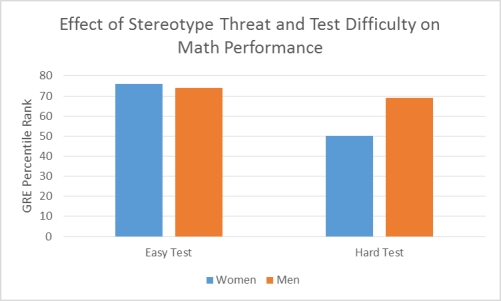Use the following to answer questions
Scenario III
Scenario III is based on fabricated data inspired by the following study:
Spencer, S. J., Steele, C. M. & Quinn, D. M. (1999) . Stereotype threat and women's math performance. Journal of Experimental Social Psychology, 35, 4-28.
Effect of Stereotype Threat on Math Study
The myth that men outperform women in math is widely believed by many individuals. The purpose of the study described in Scenario III was to determine if a sample of women whose math abilities equaled a sample of men would fall victim to this threat. To that end, 28 adult men and 28 adult women were administered an easy math test or a difficult math test. The performance of men and women on both the easy and hard test was quantified. A two-factor ANOVA revealed a significant main effect for test, with participants scoring significantly better on the easy test. The analyses also revealed a main effect for sex, with men performing significantly better than women. The interaction between test difficulty and sex was also statistically significant. Further inspection of the data revealed that although men and women did not differ on the easy math test, women performed significantly less well than men on the difficult math test. Given that the screening criteria for participants including earning a grade of B or better in college calculus, and scoring in at least the 85th percentile on the math subsection of the ACT, the current study indicates that women do succumb to math stereotype threat but only when the math challenge is great. The data are presented in Figure 2.
 Figure 2. Although women and men performed equally on an easy version of the math test, women performed significantly worse than men on the difficult version.
Figure 2. Although women and men performed equally on an easy version of the math test, women performed significantly worse than men on the difficult version.
-(Scenario III) According to Scenario III, there was a main effect for sex, with men performing significantly better than women. To arrive at this conclusion, the researchers would have had to examine:
Definitions:
Classical Conditioning
Classical Conditioning is a learning process that occurs when two stimuli are repeatedly paired: a response that is at first elicited only by the second stimulus is eventually elicited by the first stimulus alone.
Habituation
A simple form of learning where there is a decrease in response to a stimulus after repeated exposure.
Operant Conditioning
A method of learning that uses rewards and punishments for behavior to increase or decrease the likelihood of a behavior being repeated.
Cognition
The mental action or process of acquiring knowledge and understanding through thought, experience, and the senses.
Q13: Dr. Raqui computed a two-way factorial analysis
Q26: In an A-B-A design, after removal of
Q27: Fix It<br>Genie is a first-year doctoral student
Q42: Participants in the _do not receive treatment
Q57: Study interactions permit researchers to mimic the
Q73: Dr. Pullman had an overwhelming number of
Q89: The _ is the person who asks
Q127: Professor Marks is most interested in whether
Q135: Which of the following statistics is produced
Q170: Which of the following is NOT an